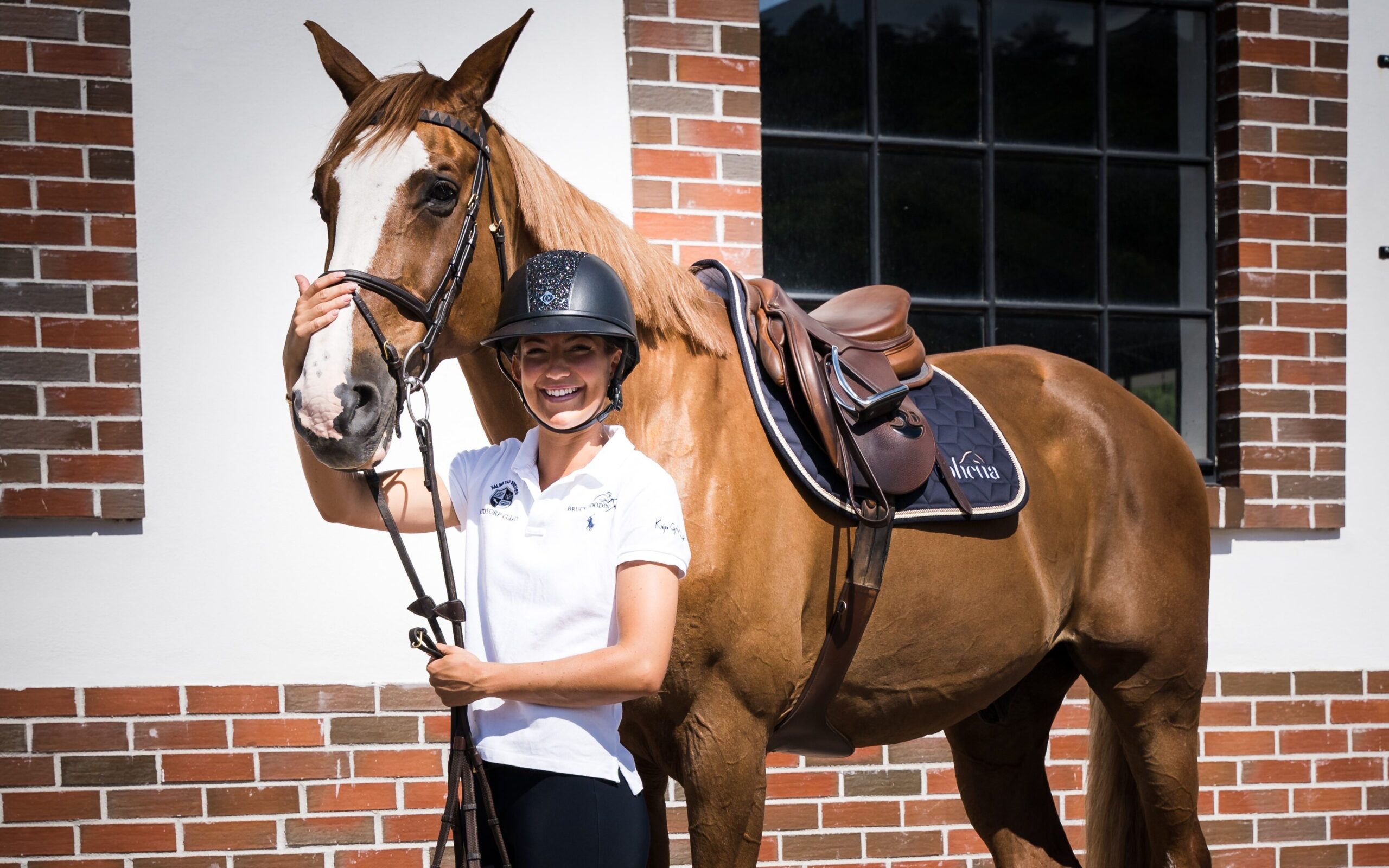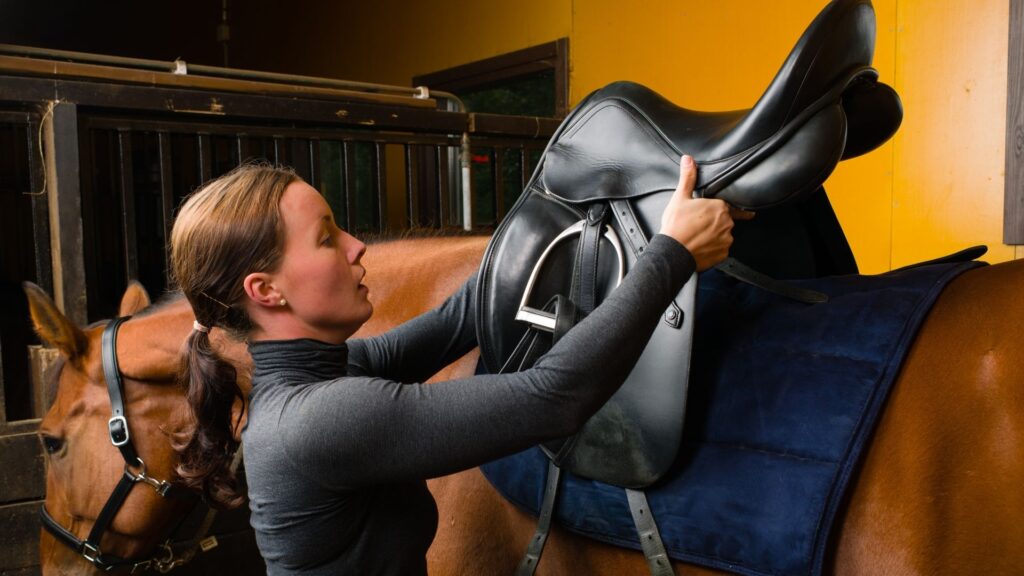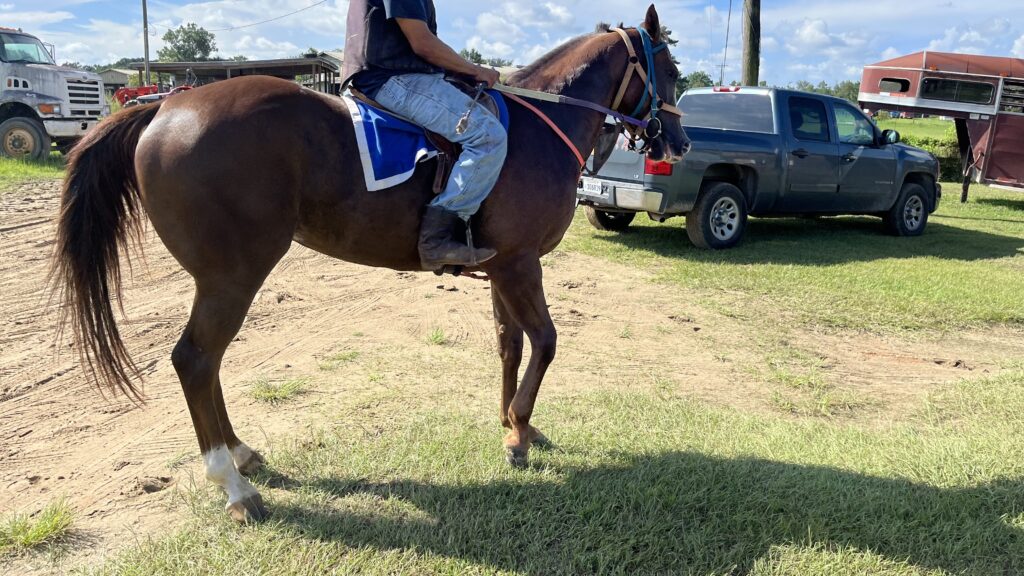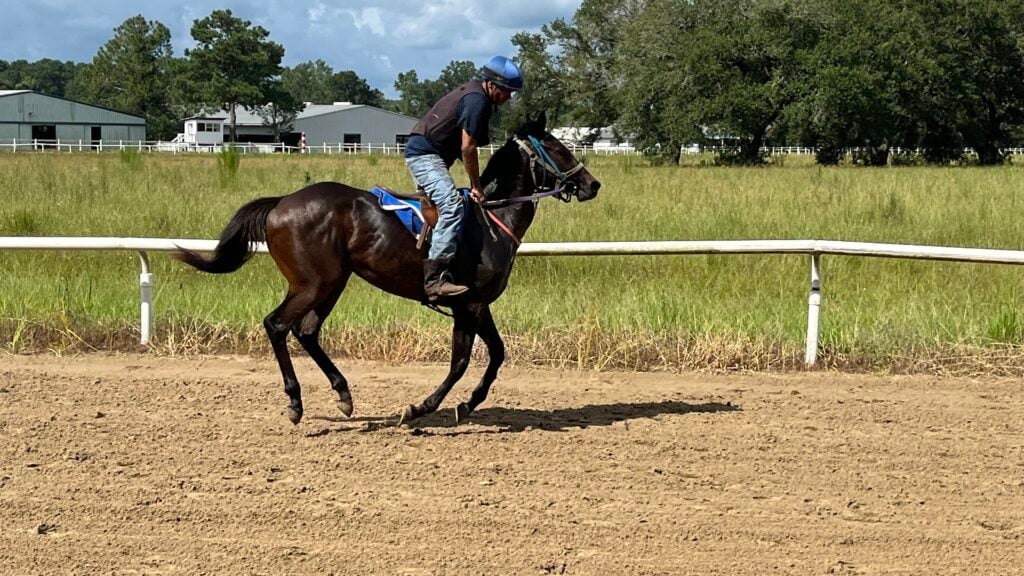Last updated: September 5, 2022
Any links on this page that lead to products on Amazon are affiliate links and I earn a commission if you make a purchase. Thanks in advance – I really appreciate it!
Finding the right size saddle is important not only for the horse but the rider as well. A saddle is a connection between you and your horse; both rider and horse need to feel comfortable and able to move to effect the correct aids and for the horse to have the freedom to execute the movement.
A saddle that fits the rider correctly will give the rider a balanced position in the center of the saddle with between 3 and 4 fingers space behind the seat to the cantle and the same in front of your seat to the pommel. Your knee should rest comfortably into the saddle flap and knee rolls.
Finding the right size saddle can be tricky as you have to look at the seat size and flap size to ensure you have an overall well-fitted saddle for the rider. Then there is the matter of finding a saddle to fit your horse’s back.
For this article, I got some help from Sarah; she is a master saddle fitter from the UK with 13 years of experience.

How To Measure Saddle Size For A Rider?
Measuring an English saddle size for the rider does not only mean fitting the rider’s seat but also includes the length of the flap and width of the twist; all play an important part in ensuring a correctly fitting saddle that will allow the rider to sit comfortably balanced in the seat.
Seat Length
Sizing a seat for a rider can depend on a few factors, such as the size, length, age, and gender of the rider, and the best way to determine the right size is for the rider to sit in the saddle.
In general, the below guideline provides a rough estimate of rider sizes for saddle sizes.
- Small children 14″ to 15.”
- Juniors to small adults 16″ to 16.5.”
- Average adults 17.”
- Larger adults or tall adults 17.5″ to 18.”
- Extra-large adults 18”+ or extra forward flaps
(This can sometimes become custom-made saddles)
Sit into the saddle’s center and adjust your stirrup straps to the correct length according to your discipline; dressage riders will have longer legs than jumpers.
Your knee should comfortably be positioned behind the knee block with your leg hanging in the correct position under you.
If the saddle is the right size, it should have a clearance of a hand, about four fingers, between your seat and the top of the cantle.

Seat Width
The twist is the narrowest part of the saddle and should fit the pelvic structure of the rider. The pelvic structure can vary by weight, age, and gender, and should feel comfortable to the rider to ensure the seat bones can properly support the rider.
Flap Size
A saddle may fit you perfectly on the seat size, but if you find yourself either with your knees pushing over the knee block putting your leg in an uncomfortable position, or pushing your seat backward, creating an unbalanced position.
This is where ensuring that the flap is the correct size for the rider will allow you to sit comfortably in the center of the saddle. Some taller riders will need to go with a saddle with an extra forward flap or may need to increase the seat size by a half inch.
Another area to look for on the flap is the bottom of the flap. If the flap is on the short side, it will catch on the top of the rider’s boots. Too long, and it may hinder the lower leg commands on the horse.
Why It’s Important To Fit A Saddle To A Rider
Apart from the safety issue of having a saddle that is too small or big for the rider, a properly fitting saddle is important to the rider and horse’s comfort.
Your ability to move without the feeling of being restricted by a small saddle or flopping around in an oversized seat will allow you to convey the correct aids through your seat to the horse and will optimize the rider and horse’s performance.

How To Fit A Saddle To Your Horse?
Once you have found a selection of saddles that feel comfortable and fit all the criteria we discussed, it’s time to make sure that it also fits your horse to give him the same amount of freedom and comfort to perform at his optimum.
Step #1: Saddle Position
Place your saddle over the withers, and with your palm on the pommel, push the saddle backward until it stops. The saddle should naturally position itself behind the horse’s shoulders.
The saddle should never be placed too far forward over the withers as this will hinder the horse’s shoulder movement.
Step #2: Fitting The Points
These three points of the saddle should run parallel to the horse’s shoulders. You can find these by lifting the saddle flaps; they are tucked into a small leather pocket in front of the stirrup bars.
To assess that the points fit, stand next to the horse’s shoulder and lift the saddles flap, look at the points, and with your eye, determine if the point is parallel to the horse’s musculature.
The saddle will tip backward when the points are too narrow, creating uneven pressure under the panels.
If the saddle’s points are too wide, the saddle will push down over the withers causing the saddle to lift behind and creating a pressure point on the horse’s withers.
Step #3: Panel Contact Pressure
The panels are the wool stuffed or foam panels on the saddle’s underside, which is the cushioning between the horseback and the saddle tree.
Once the saddle is in position and the points are parallel, place one hand in the center of the seat and press down to secure the saddle. Run your other hand down the saddle between the front panel and the horse’s shoulder. There should be an even pressure from the top to past the saddle point.
Then place your hand underneath the saddle running down from the front of the panel to the back of the saddle (pommel to cantle). The pressure should feel even from front to back. If you have a gap at any stage of the panel, there will be a pressure point on your horse’s back; likewise, if the saddle is too wide, the pressure will be uneven, with a pressure point in the center of the saddle.
If you have constant pressure from front to back, you can move on to the next step.
Step #4: Saddle Balance
Saddle balance is important to the rider and will allow you to sit in the center of the saddle with your legs well balanced underneath your center of gravity.
Cantles should always be higher than the pommel; depending on what type of saddle you are fitting, cantles can vary in height. The cantle can vary between three to four inches higher than the pommel in deeper seats like dressage saddles. In shallower seats, like the close contact, the cantle will only be about one to two inches higher than the pommel.
If your cantle is level or lower than the pommel, your saddle is unbalanced and will force your legs forward, creating an unbalanced seat and putting pressure on the horse’s lower back.
Step #5: Seat Position
Look at the seat position of where the rider should be sitting. This is the deepest part of the seat and should be level to allow the rider to sit squarely on their seat bones and have a natural balance on the horse.
Step #6: Clearing The Withers
Ensuring that the saddle clears the withers is very important and can sometimes be trickier than it seems and is often the reason horses complain the most.
The pommel should clear the horse’s withers with a comfortable two to three-finger space without using a saddle pad. Wool panels should be given about a half-inch settling allowance.
If the saddle is higher than three fingers, the saddle is too narrow, and you will find the seat balance is also tipped backward.
If there is less than two fingers of space between the pommel and withers, the saddle is too wide, and the rider’s balance will tip forward.
Step #7: Allow Enough Channel Width
Each horse is unique in its shape and skeletal structure, and ensuring that that channel or gullet (the hollow space running between the two panels) is wide enough is important to allow the horse to have room for his spine to curve and for his back to flex.
Horses with wider spines need a wider channel, whereas horses with a slightly protruding spine need a deeper channel.
The panels should not rest on either side of the horse’s spine and should only make contact with the horse’s longissimus dorsi muscle.
Steps 6 and 7 should be repeated with the rider’s weight in the saddle to ensure sufficient clearance.

Step #8: Ensure Your Saddle Is Stable
This step is best evaluated with the rider in the saddle.
Allowing the rider to do some groundwork and jumping to ensure the saddle does not ride up the horse’s neck jamming the points into the shoulder blades. Another point to look for is if the saddle bounces off the horse’s lower back, creating an uncomfortable ride and jolting the horse’s back muscles.
While the horse is moving, the saddle should remain stable and still on the horse’s back with minimal rocking back and forth or side to side; this is especially important when posting on a horse.
Step #9: Have The Right Seat Length
The length and size of the saddle are as important to the horse as it is to the rider. A saddle should never go past the 18th (last) thoracic rib vertebra. A saddle over this point rests on the weakest part of the horse’s non-weight bearing area.
Conclusion
Like any other athlete, ensuring your equipment fits you well is important to the success of your performance. So is fitting a saddle to the rider’s seat, but it goes further than that, and since you and the horse share the same equipment, it is important that the same saddle fit the conformation of the horse.
This article focuses on fitting an “English” saddle, but if you’re interested in Western saddle sizes, I suggest you visit my other blog post: How Do I Know What Size Western Saddle I Need?
Below is a helpful YouTube video that shows how an English saddle should fit a horse and rider.
FAQs
Are all English saddles the same size?
No, not all English saddles are the same size. There are different types of English saddles; for example, dressage saddles tend to be smaller than jump saddles. In addition, the size of the horse also plays a role in determining the size of the saddle.
What size English saddle for a 10-year-old?
There is no definitive answer to this question as each child has a different build. However, an average-sized 10-year-old child should comfortably fit a 15-inch saddle.
References
- https://en.wikipedia.org/wiki/Saddle#Rider
- https://en.wikipedia.org/wiki/English_saddle#Fitting_the_rider
- https://www.smartpakequine.com/content/saddle-fitting-guide#:~:text=For%20the%20rider%2C%20the%20saddle,not%20push%20against%20the%20back.
- https://www.doversaddlery.com/how-to-select-and-size-an-english-saddle-for-a-rider/a/519/
- https://www.fei.org/stories/lifestyle/teach-me/perfect-equestrian-saddle-advice-3-steps

About the Author: Miles Henry
Lifelong Horseman | Racehorse Owner | Published Author
Miles Henry brings over 25 years of hands-on experience training and owning Thoroughbred racehorses. Raised with Quarter Horses and Appaloosas, he’s spent a lifetime learning from horses—on the track, in the barn, and in the field. Today, he runs a small but successful racing stable in Louisiana and shares real-world insights on HorseRacingSense.com, helping horse owners, fans, and bettors navigate the sport with confidence.
📚 Books: View Miles’s books on Amazon »
🎧 Podcast Guest: Animal Tales Ep. 32 |
YouTube Interview
📩 Newsletter: Sign up for racing tips and horse care advice »
🔗 Follow Miles:
Twitter |
Facebook |
YouTube


